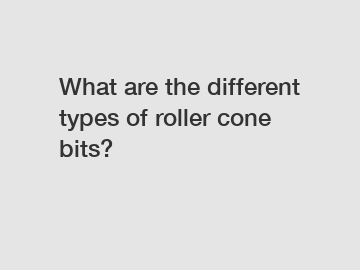Dec. 29, 2023
Tools
GRANDDTS contains other products and information you need, so please check it out.
What Are the Different Types of Roller Cone Bits?
When it comes to drilling in the oil and gas industry, roller cone bits play a crucial role. These drill bits are designed to crush rocks and break through various types of formations. Roller cone bits consist of one or more cones that have rows of teeth or buttons. As the bit rotates, the cones roll against the bottom of the wellbore and the teeth or buttons break the rock. However, not all roller cone bits are the same. In this article, we will explore the different types of roller cone bits and their applications.

1. Steel Tooth Bits.
Steel tooth bits, also known as milled tooth bits or mill tooth bits, are the most commonly used roller cone bits. These bits have cones with embedded steel teeth that are formed by machining or milling the cones. The steel teeth can vary in shape and size depending on the type of formation to be drilled. Steel tooth bits are ideal for drilling soft to medium-hard rock formations such as limestone, shale, and sandstone.
2. Tungsten Carbide Insert (TCI) Bits.
TCI bits, sometimes referred to as button bits, have cone inserts made of tungsten carbide. These inserts are typically pressed into the cone body and have superior hardness and wear resistance compared to steel teeth. TCI bits are suitable for drilling hard and abrasive formations, including dolomite, granite, and hard shale. The buttons on the cone inserts come in different shapes and configurations to optimize their drilling capabilities in specific formations.
Suggested reading:3. Journal Bearing Bits.
Journal bearing bits, also known as friction bearing bits, use a lubricant-filled journal bearing system to support the cones' rotation. These bits have a simpler design compared to roller bearing bits, making them more economical. However, journal bearing bits have a shorter lifespan and are generally less durable than roller bearing bits. They are typically used in shallow wells or for drilling through less challenging formations where cost is a significant factor.
4. Roller Bearing Bits.
Roller bearing bits are designed with roller bearings that support the cones' rotation. These bearings reduce friction and heat generated during drilling, providing better efficiency and longevity compared to journal bearing bits. Roller bearing bits are widely used in deep drilling applications and are ideal for drilling hard formations. The roller bearings allow the cones to rotate more freely, making them more suitable for higher RPM and higher torque operations.
Closing paragraph:
In summary, roller cone bits are essential tools for drilling in the oil and gas industry. Understanding the different types of roller cone bits and their applications is crucial in optimizing drilling operations and achieving success. Whether it's steel tooth bits for soft formations, TCI bits for hard and abrasive formations, journal bearing bits for shallow wells, or roller bearing bits for deep drilling, choosing the right roller cone bit can significantly impact drilling performance. If you have any further questions or need assistance with roller cone bits, feel free to contact us.
Contact us to discuss your requirements of iadc code for pdc bits. Our experienced sales team can help you identify the options that best suit your needs.
Suggested reading:Related Articles
If you are interested in sending in a Guest Blogger Submission,welcome to write for us!
All Comments ( 0 )